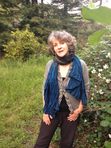Patricia Damery's Blog, page 13
May 25, 2015
Learning to Live with a Keystone Species!
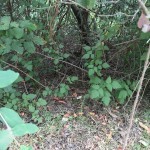
If you look carefully, you can see the nest, which looks like a pile of brush but is carefully constructed.
Learning to live with a keystone species sometimes takes time!
The four foot pyramid-shaped pile of sticks and branches in the understory of a canopy of coastal live oak immediately caught my eye. I had never seen anything like it. Obviously, something had built this structure, yet to my uneducated eye, there was no indication as to what. The structure was located in the far upper reaches of our ranch. Everyday I passed this architectural marvel as I walked the ridge trail that traces that line where forest meets meadow and oak savanna. Each time I examined the area around the structure. Sometimes it appeared a coyote or some other animal had been digging into the side, but the identity of the animal creating this structure remained a mystery to me— until one day a friend’s scientist daughter identified it: This was a wood rat nest, the home of what is more commonly known as packrat.
I was fascinated and thought it a rare find until I found six such structures under the blackberry bushes along our remote driveway. The structures were about 20 feet apart, and again, there was no evidence of the rats, at least not in daylight hours when I could actually see them. I learned later that these structures can be as old as 70 years.
My real encounter happened much later. I was driving my new Prius to San Francisco when several warning lights came on at once. I pulled to the side and checked the owner’s manual: I needed to get to the nearest dealer immediately, which fortunately was at the next exit. I was flabbergasted to learn that my wiring had been chewed to the tune of $12,000 and in the space of the two evenings since my last servicing!
So rodents love Prius’ wiring, I was told. I live in the country and we have no garage. I wasn’t going to get rid of my car, so I was going to have to learn to live with this predator of electrical wiring.
My continuing efforts includ7 keeping the hood open so that the warm engine does not provide a haven for a cold rat. One winter evening I remembered that I had not opened the hood and rushed out to do this. When I lifted the hood, a wood rat sat on the motor rubbing her paws together to warm up! Yes, I admit that I reluctantly set traps under the car and in it, as well as on the motor, and I caught several. I still carry electric traps on the floor of the car.
A friend told me that Irish Spring soap repels rodents. Wood rats eat it. My bars had gnaw marks all around the edges, and I had green soap crumbs all over my floor mats. Also, it almost fumigated me. I sprayed pepper spray under the car, under the hood, and even on the floor mats (I do not recommend the latter), and this worked some.
But I also soon began to find odd objects in my car, objects that I had never seen: a black plastic tube with loops along the side that had no apparent function, feathers, pens that were not mine. One day I opened the package compartment to find the odd plastic tube (yes, I had not thrown it out) and its loops were woven through by a feather. Later I learned these rats decorate their nests with anything that they consider appropriate. Was my car now synonymous to them with their nest?
I continue to suffer higher car maintenance bills due to having to have the air filter changed frequently and having to have regular rodent cleaning of the engine ($300 if no damage). But I feel better about it all now that I have also learned that these rats are a keystone species and an indicator species. Their presence reflects a healthy ecosystem and is critical to the continuance of health of the system. They are a food source for a variety of animals, including barn owls and great horned, hawks, coyotes, bobcats, mountain lions, and gopher and rattlesnakes. They are nocturnal, so we seldom see them, but it is said that if you shine a light into a tree over their nests at night, you will see shining red eyes (This is not something that I have done.) I actually look forward to what has happened since I was last in the car (you never know!) And perhaps most important, in this time when so much is dying and the climate and environment is so changed, it is a relief to see these survivors teaching me how to live with them, even if they sometimes cross the line!
The post Learning to Live with a Keystone Species! appeared first on Patricia Damery.
May 12, 2015
Psychological Complexes and Soul’s Agenda
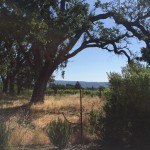
Leaning Valley Oak next to vineyard
The thick, old valley oak in the cemetery by the vineyard is leaning, the one that has witnessed a hundred burials in the ground beside it these last 150 years. The ancient valley oak beside the little pioneer house fell last May, and then, on the other side of the house, we had to cut the old Monterey pine, diseased and dangerous. The drought-weary forest of the western reaches of the ranch is populated with dying coastal oaks and madrone, some from insects that have moved in on thirsty trees, some from the pathogens of Sudden oak death. In the 21 years that I have lived on this ranch, I am beginning to realize that I have witnessed a decided lessening of the vitality of the forest. Is this the result of excluding fire from these forests? Of not maintaining them, as the natives before Western Europeans did? Or are we in a death cycle, perpetuated by drought and climate change?
I am aware of how grief can separate me from this land which is so dear to my heart. Grief can automatically shrink-wrap me. I see everything, and yet, emotionally, I stand apart. It is hard to allow an openness to the beauty of that which is changing so drastically—even the valley oak savanna south of our kitchen with its native grasses and ancient trees and ceremonial sites that a new neighbor wants to plant in vines.
I wonder if we are born into circumstances that create the psychological ground upon which our souls have incarnated to evolve. I grew up with a sick mother, whose survival I worried for every day of my life— until she died at aged 80! This worry shaped my relationship with her: I held myself a little apart, thinking I could rely only on myself. I am sure that it influenced my entry into a healing profession. Years of my own personal analysis helped this wounding, and yet, the sick-mother psychological complex created a kind of processing organ within my psyche. I feel it now: The threat to Mother Earth, and her vitality, reflexively makes me want to shrink, hold myself apart so I feel less pain. And yet, as I know from experience, if I stay open-hearted, even to the potentiality of loss, I am expanded into an intimacy with the Other. Grief experienced, paradoxically opens our hearts.
As a Jungian psychoanalyst, I often see this larger function of what we call “complexes”. Too often these patterns of behavior are seen as maladaptive and needing to be healed so they do not overcome us. Yet, does the integration of the consciousness gained around this analytical, psychological work of these patterns, offer a larger spiritual function, preparing us on a personal level with tools to process issues that have both spiritual and collective significance? Is this some of Soul’s agenda?
For me, at least, the years of work with my fear for my mother’s survival has helped enormously in staying present through witnessing Mother Earth’s changes. In so doing, it even allows (hopeful?) ground for action.
The post Psychological Complexes and Soul’s Agenda appeared first on Patricia Damery.
May 4, 2015
Land and the Human Soul
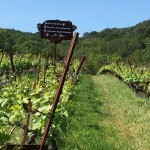
A sign to remind us in our vineyard.
What damage do we do to our own souls when we treat the land as if we own it?
This is a question that often inspires incredulous rage fueled by the assumption of the primacy of property rights. I remember a phone conversation several years ago with a new next-door neighbor whose vineyard management company was flail mowing a meadow of native grasses, sending clouds of dust onto our soon-to-be harvested lavender. I told him that the mower did not need to be cutting into the ground, destroying the root structure of native grasses. “Are you telling me how to farm my own land?” he spouted.
Actually, yes. We had lived by that meadow for two decades, my husband for three decades. We had botanists identify native plants still surviving (and there are quite a few). We learned how to select for these plants in grazing/browsing our goats on our own land and in mowing techniques (when and how short). We had something to offer our new neighbor as he became acquainted with the land he had just bought (and yes, I was feeling some propriety!)
The question of property rights shape-shifts as we face the challenges of changes in climate, the rising of seas, the extinction cycle we are in. What we do on our “own” land not only affects our land, but the larger ecosystem it is in.
And it’s not about stewardship either. I remember Stewardship Sunday in June when I was a child in a small country church. Our fathers were all farmers. We felt this urgency to take care of the earth in our care. But stewardship is another patriarchal construct that is only a step away from dominion-over. Although many of our fathers were also in communion with the soil, the water, the weather, the seeds they planted, at least subconsciously, they also were quickly converted to the use of dominion-over techniques in caring for “their” land: herbicides, ammonium nitrate fertilizer to push production, and then GMO seeds. These techniques have a deleterious affect on soils, water, and, as it turns out, the ground of our own bodies’ digestive systems.
We are in an evolutionary cycle in which Nature is having her say. She cannot be suppressed or ignored, or she will come back in a vengeance, as she is! We must learn to stop doing things that damage our environment, and we must also learn to live in ways that support its health. But if we are to survive and to evolve, we must listen to the natural world and learn her language. This is key! We live in a world in which we are only one part of an interrelated community which includes plants, animals, and soil microorganisms.
The skills required for this transition come from the human heart and love. Taking in our part in the whole expands us, and builds soul. The soul’s organs allow for seeing and hearing in ways beyond our five senses, in ways Nature speaks. When we attend to the soul of the world (for that is what we are then doing), we grow stronger–and so does the world. We feel the relationship between land and the human soul.
The post Land and the Human Soul appeared first on Patricia Damery.
April 23, 2015
Heaven in Earth: Earth Change
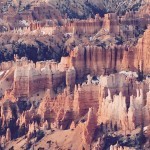
Sunrise at Bryce Canyon
Bryce Canyon National Park: 8000 feet.
Why is it that I feel haunted here? It is true that the rarified air brings memories of camping trips in the high country of Yosemite when my sons were young, of sipping black currant tea at the picnic table late afternoons while they napped in the camper. Yes, there is that uniqueness of the dry heat of midday trails and the pinch of cold at night around blazing campfires. The high country places demands on the body: at first, the great need for water, then rest to ward off headaches and nausea, and then, after two or three days, if you take it easy, the payoff: a coming ease of air in lungs and the experience of absolute lightness. It is an experience of following your body’s agenda!
My husband and I have come to Bryce Canyon and Zion National Parks in preparation for a talk I am to give on environment and psyche at a Jung Institute event in December (Celebrating composer Messiaen’s Des Canyons Aux Etoiles ,“From the Canyons to the Stars”— more to come on this). Messiaen’s piece was inspired by both Bryce Canyon and Zion.
I have never been in these particular environments before. I am overcome with the feeling of companionship even as I hike alone. The feeling is close to nostalgia, and certainly the thin air and the sound of the wind through pine needles are familiar and bring happy memories. But something different is here too, a whisper that I cannot quite hear— and the hoodoos (tall towers of eroded rock so prevalent in Bryce Canyon) are otherworldly and strange. As I read the history of this land, which until the last century was Southern Paiute territory, I question: do I feel the ancestors of this land? Southern Paiute Clifford Jake said, “The rocks, they got a song in it, the traditional songs… The song comes from the murmur of the wind, the murmur of the trees and birds.”
Am I hearing a song? What song is in the rocks these days? There is so much grief— of ways of life ended; of languages forbidden, then forgotten; of ancestral lands taken by Mormons for building their own Kingdom of God, by miners for the gold and other minerals found here, by cowboys and the Navajo for rangeland.
Yet the song of holiness is here too. When people emerge from the lodge at Zion National Park, without exception, they reflexively look upward: up past the gigantic cottonwood that shelters picnicking families throughout the day, up the verticality of cliffs, and farther up, to the turquoise sky. In moments like this we feel our smallness. We feel the Divine. The maze of the canyons of Zion are unlike any I have experienced. They go on and on, mile after mile. You are dwarfed in beauty, for hours or days. Beauty, perceived by the heart, is a portal to the Divine, and the beauty here is relentless.
And this awe is in Bryce Canyon too. Scores of people gather before dawn on the rim to watch the sun appear over the mountain to the east and illuminate the awaiting hoodoos below.
I can only image the grief of those who knew these lands for centuries, or millennia, who depended on the places within these canyons for good water, to harvest grasses and piñon nuts, and hunt game. Southern Paiute territory was desert, extending over large parts of southern Utah, and into Nevada, California, and Arizona. In such a difficult desert environment, spiritual perspective became a necessity for survival of the soul. As Southern Paiute Kaibab Band Vivienne Caron-Jake puts it, “They each had a strong spiritual sense of self, rooted to their relationship to the land and all living things (Hebner, Southern Paiute: A Portrait, p. xii).
In this time of environmental crisis, there is much to learn from our Earth and from people who have revered it. Land that has been related to in sacred ways, glows. Zion and Bryce glow. In that soft goldenness, we are in the eternal present. Then we might feel that “touch” of something else, “hear” the ancestors speak and the songs the rock still knows. In this time of great earth change, perhaps they remind us that Heaven is in Earth, if only we slow down, accept even heartbreak of great loss, and walk the spiritual path of receptivity to that land which sustains us.
The post Heaven in Earth: Earth Change appeared first on Patricia Damery.
April 17, 2015
Respect of Water as a Living Entity
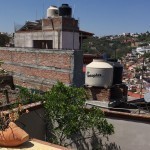
Guanajuato: Most rooftops have small water holding tanks, or tinacos.
Visiting friends in Guanajuato, I experience what a different relationship these people have with water, at least from us in California— and United States, for that matter. Respecting water is so much more immediate and personal. If water is short, it is turned off by the city. You are left with what is in your tinaco, or roof holding tank, if you have one, or what you have stored in bottles and buckets. You do not let water run down the drain until it gets hot: you gather it in buckets and use it to flush the toilet. Because city water is contaminated, you use only purified, filtered, or bottled water for drinking or brushing your teeth. And you use bottled water prudently as well, as in Guanajuato it has been hand carried up or down stone steps to your door from distant places, as water has been carried for ages.
This part of Mexico has had more rain these last four years than the West of United States, but residents are still careful about how they manage water. With this kind of care, water becomes a living entity, and the care of water, an act of respect. It is a respect that we must acquire in California, a respect that must extend to all things of the earth. We have used water as if it is limitless, and the dark lesson of the drought is this: it is not limitless, and it has requirements for its health.
In several places I have written about the November 2014 Future First! Second Women’s Congress in Minneapolis in which over 450 of us drew up a Bill of Rights for Water. We divided in groups to list the rights of streams, aquifers, lakes and oceans, as well as our responsibility to these various gatherings of water. (See blogs: Joanna Macy and Sustaining the Gaze; Mary Pipher’s Answer to Willful Ignorance; A Bill of Rights for Water; Supporting Pollinators and Future First! ) Attorneys, psychologists, biologists, and laypeople worked to form a document that is both authoritative and poetic. And because in some indigenous cultures the law is sung, and several indigenous cultures were represented, the last day the final result was sung as the attorneys presented the document to the Congress. It begins:
We, the women and men of the second Women’s Congress, have gathered on behalf of the waters of the world. Water speaks as one voice. She weaves together and through the lands of the world, has deep seas above and below the surface, flows from the mountaintops and in the veins of every living being. She has spoken and we are opening our ears to listen. The song she sings is one of deep anguish. She is calling upon us to be her guardian.
We have much to learn about being guardians of the waters of the world from cultures who have made do with much less. Implicit in many of these cultures are methods that afford an intimacy and a resulting respect for water. And for many of us it may involve things as simple as a bucket and a prayer offering our gratitude to Living Water.
The post Respect of Water as a Living Entity appeared first on Patricia Damery.
April 3, 2015
Dowsing and Evolution of Consciousness
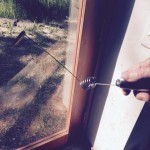
A very sensitive instrument my father never used!
My father taught all of us kids to dowse. He was a quiet man, farming all his life, probably an introverted feeling type, but it is hard for a daughter to tell! In the early spring he could hardly wait until the fields were thawed and dry enough to plow, disk, harrow, and plant. Winter and its fallowness made him antsy and irritable, but Mom would remind us, spring plowing changed all this. When the earth thawed, he worked until after dark, falling asleep as soon as he hit his chair in the evening, but he was also relaxed and at peace, and out the door the next morning at first light.
He was a good listener, especially to the earth. He knew her language. When April and May brought rains, flooding the fields, he bent two coat hangers into L’s, holding them loosely in each hand, and relaxed as he walked the field, in resonance with Earth and Water, Air and Sun. When he reached the buried broken tile, the coat hangers crossed. That is where he dug.
Recent research has shown how important this state of consciousness is, a state shown to be in resonance with the earth. This resonance appears to be connected not only to our sense of well being, but also to our evolution of consciousness. This month’s (April) issue of Creations Magazine published my article, “On Health, Healing, and Our Relationship to the Earth“, an article that comes from my roots but extends into our future. Dowsers, and other meditators, have learned to use brain waves and parts of the brain in ways that may well reflect an evolution of consciousness.
My father would not have cared about this evolution, I suspect. He cared about the feeling he got when he was in partnership with the earth again in the spring. He relaxed, and I suspect that he got energetically larger. Perhaps the earth did too.
The post Dowsing and Evolution of Consciousness appeared first on Patricia Damery.
March 22, 2015
March 22: World Water Day: California’s Crisis
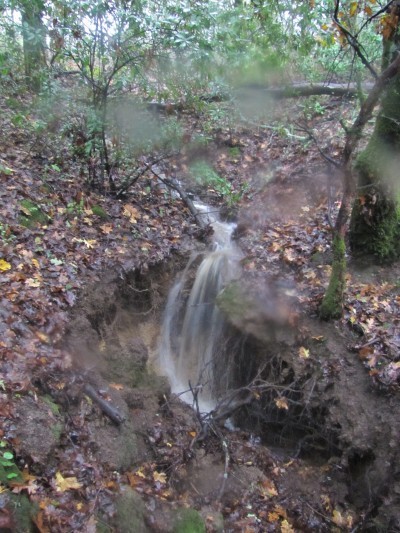
Water on its way to Dry Creek.
Today, March 22, 2015, is World Water Day, a day designated by the United Nations in 1993 to celebrate Water.
Being in our fourth year of drought, there never has been a time that Californians are more aware of water. Many of us may be joining the 780 million people of the world who do not have access to safe drinking water, NASA projections saying California has one year of water storage left.
In commemoration of this day, I offer links to two articles coming out this month in Jung Journal, Culture and Psyche. The first is my interview of Charlie Toledo, The Water Crisis in California: an Interview with Charlie Toledo. Charlie worked on the formation of the Watershed Development plan for Napa County in its seminal years, 1992–1995, and more recently serves on a state advisory board that functions as a consumer oversight of the California Public Utilities Commission. She brings indigenous wisdom and knowledge as she discusses current water legislation in California and what is needed to meet the crisis, viewing Water as alive and sacred. The second article, On Water—and Fire, is a meditation on a reflective approach suggested by one of Jung’s favorite stories, The Rainmaker. In this article I consider the question, Is it hubris to think that shifting our consciousness can have an impact on the outer world?
But there are the practicalities, too, that all of us on earth are going to have to consciously consider for here on out. We are running out of high quality water. The World Health Organization suggests that each of us on earth needs only about 2-5 gallons a day to meet our needs. This is far less than the 150 gallons a day Californians have been using.
Earth will always have the last say, and never more so than with that which unites us all: Water.
The post March 22: World Water Day: California’s Crisis appeared first on Patricia Damery.
March 12, 2015
Thank the Goddess for the Love of Napa Valley NIMBYS!
Many of us are reluctant of being characterized as NIMBYs when we object to projects in our “backyards” such as event center wineries or vineyard incursions into our hillsides and watersheds. Such a designation often implies a narcissism. The American Dictionary defines NIMBY (Not-In-My-Back-Yard) as “a person who objects to the siting of something perceived as unpleasant or potentially dangerous in their own neighborhood, such as a landfill or hazardous waste facility, especially while raising no such objections to similar developments elsewhere.” Many definitions include that this objection is to a project that is also for the common good.
We protect what we love. Many of us, and maybe most, love this NapaValley we call home. A project next door which we perceive as harmful in some way to us or to our environment, sparks this love. Often our individual situations reflect much larger issues in our county, in our country and in our world. It wakens us to the way things may be out of balance, and in the case of land use issues in our Valley, to the ignorance that would further degrade our hillsides and watersheds, our air and community fabric, whether that ignorance be our own or of those ambitions seek profit, regardless of impact. These projects often pushed by developers and financial interests can rarely be called in service of the common good.
Thank goodness for NIMBYs! But our love of homeland and our life here—our sense of place—must extend to a larger vision of where we are going. Vision 2050 is a growing movement in Napa County in which a dozen-plus local citizen groups are gathering out of love of this land and our lives here. We are in serious need of changes in our policies around the environment and water, climate action, and economic pressures that have defined our commerce without substantive regard of those who implement it: our farm and hospitality workers. This is a movement that needs all of us: residents, growers, wineries, laborers and local governing officials— to join in truly acting for the common good.
The post Thank the Goddess for the Love of Napa Valley NIMBYS! appeared first on Patricia Damery.
March 1, 2015
Physical Labor and Multidimensional Consciousness
My spiritual teacher Norma T. ( I write about my time with her in Farming Soul) once told me that it is easiest to develop spiritual tools to access multidimensional consciousness when we have direct contact with nature. I instinctively knew this to be true, familiar with the state of mind that comes when I walk the deer paths of our ranch, or stare into the green depth of the meadow south of our kitchen, or moderate the lively “chatter” of the garden, its many plants clamoring: More water! or I don’t want to grow next to the carrots! or The plantain is in my space!
Even as a child I knew working in the garden brought tired muscles and a rested mind, one open to the more subtle language of onions and peas, of cabbage and tomatoes. I recognized this state in my father’s rested look in the spring when he finally got into the fields to plow. I ascribe my ease in entering the realms of the quieted mind to the physical labor that we kids were forced into, or so it seemed at the time! We walked rows of soybeans in the early summer, cutting out milkweed and pigweed with sharp hooks, before joining de-tasseling crews for the local corn seed grower in July. After harvest we made a few extra bucks for the church youth group by picking up corn, throwing dropped ears into an old green wooden wagon pulled through the fields by one of our fathers. We often joined our fathers and yapping collies as we did the yearly cattle drive down the country roads from one cornfield to another. The cows feasted on the corn and corn stubble before the freeze and snows of the extensive winter. And as I remember it, we kids always complained! And yet, we loved the tasks: the community of them, the games and storytelling that would come in the work, or the simple state of mind that comes from being in the flat Illinois prairie alone or within proximity with others, but doing the same task over and over, resting in a largeness we could not then consciously recognize.
I did my own version of this “forced labor” aspect of boring physical tasks with my own sons, knowing the importance of it to consciousness, and my sons did their own version of complaining! The monotony of doing a physical task over and over in the natural world opens us to the language of the spheres, one might say! It is a meditation: the rational mind lets go at some point, and there is a openness that replaces everything. Time become irrelevant. There is only the present and the task at hand, and it goes on and on and on. Yes, boredom maybe the way a child describes it, but boredom is a portal to other dimensions— or frequencies, my architect husband likes to correct me.
So why is it I still resist the hoe? This week I am faced with the beginning task of the year: weeding the long rows of the rose geranium. Over the winter a number of interlopers have snuck under the frost cloth. I know that once begun, the scent of rose geranium will rise like fairy breath. I know time will stop, that such tasks are always portals to the gnosis of oneness, and that in spending the afternoon weeding out the large leafed weeds competing for nutrients and water, I will come away restored— if a little sore. Nevertheless, I always resist.
Are portals always sources of ambivalence?
The post Physical Labor and Multidimensional Consciousness appeared first on Patricia Damery.
February 23, 2015
Life’s Issues … and a Writing Retreat
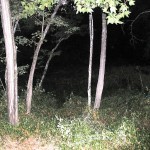
Night at Castlekeep
Life’s issues have their way of meeting us everywhere, even a writing retreat!
We six women meet once a month in this place outside of time. Castlekeep, as we have come to call it, is a large, usually unoccupied house surrounded by blackberry brambles and jonquils who’ve lost memory of flower beds. The ranch house was built on the location of a stagecoach stop and, before that, a camp for First Peoples, their middens along the creek just down the path from the house. Now its 30 acres and abandoned apple orchards are primarily a safe haven for the local coyote and bobcat populations when its owners (or we) are not spending the occasional weekend here.
Our writing group has met for the best part of 35 years, at first late into Thursday nights once a week and then monthly in this two day format. The last ten years we have met here. I value this time away from my busy life, planning work on projects that I want input on or that require undisturbed time to concentrate. To my efficient state of mind, it is critically important that I use this time wisely and carefully.
I spent all yesterday afternoon doing nothing I intended. Let me list all that I did not do: I did not write the blog I planned; I did not plan the class I teach in exactly two weeks; I did not read the next ten pages of the alchemical treatise that I am determined to finish by the end of February. I did not receive the inspiration for the Letter to the Editor regarding the land use issues in the County of Napa.
Instead I ate a forbidden wheat bread sandwich that always ends up making sores on the insides of my cheeks (because I like it), I browsed books like the goats browse the hillside, sampling only what seemed delicious before moving on to something else. I conducted a wine tasting of three inexpensive sauvignon blanc wines that I will purchase a case of for an event next weekend, drank too much in the process, and then countered by eating too much cheese to enjoy the chicken but not enough to enjoy the chocolate cake. Oh yes, and I napped.
After all was said and done, I went to bed at 9 pm and slept like a baby, awakening once at midnight with a dream about an elephant trying to drown a whale and again at 2 am to pee. But I slept 9 hours, finally rising at 6 am, when I ate a piece of the remaining chocolate cake for breakfast, and—finally! got to work— refreshed and with a certain amount of joy!
On my walk this morning I thought about the things that I fear I will not accomplish in this life. (Jimalee so kindly brought up this topic first thing.) I fear that I will never take a 6 month sabbatical to read all the books that require the quiet of a retreat space. I fear that I will never hike the Pacific Crest Trail for a summer, or even 2 weeks! That we will never live in Europe for 3 months, or six, and I fear that I will die before I retire, all experiences, I realize, that require this kind of browsing attitude.
Do I need to save some of these agendas for future lives, like you transfer unfinished items from one to-do list to another at the beginning of the next day? Then again, why am I not doing these most important things in this life? It is a question I contemplate, and then realize the price: it requires suffering the anxiety of yesterday afternoon: my agenda broke down, and something in me played. Yes, it is risky! At times following one’s interests and passions can be like being taken on a wild ride by a puca. But this time, I was restored. When I got up this morning, the words danced onto the paper, without effort, and it was play.
The post Life’s Issues … and a Writing Retreat appeared first on Patricia Damery.

